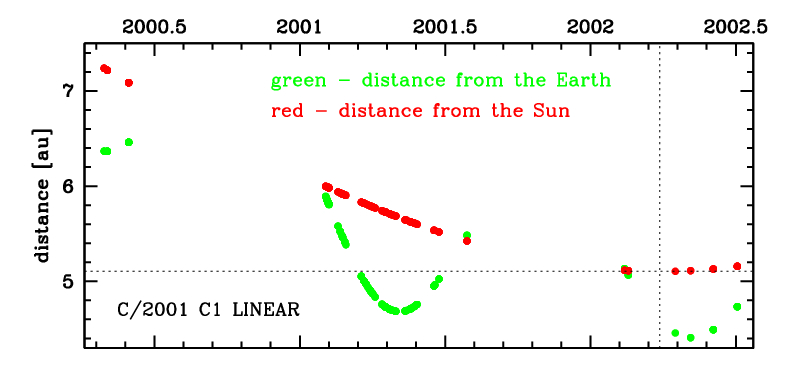C/2001 C1 LINEAR
more info
C/2001 C1 was discovered on 1 February 2001 by the LINEAR [IAUC 7578, 2001 February 2]. Later, Syuichi Nakano linked this comet with an asteroid 2000 HR81 detected by LONEOS on 29 April 2000 [MPEC 2001-H23, 2001 April 21].
This comet made its closest approach to the Earth on 7 May 2002 (4.410 au), 1.3 months after perihelion.
Solution given here is based on data spanning over 2.2 yr in a range of heliocentric distances: 7.24 au – 5.105 au (perihelion) – 5.16 au.
This Oort spike comet suffers rather small planetary perturbations during its passage through the planetary system that lead to escape of the comet from the solar system on hiperbolic orbit (see future barycentric orbit).
See also Królikowska 2014 and Królikowska and Dybczyński 2017.
This comet made its closest approach to the Earth on 7 May 2002 (4.410 au), 1.3 months after perihelion.
Solution given here is based on data spanning over 2.2 yr in a range of heliocentric distances: 7.24 au – 5.105 au (perihelion) – 5.16 au.
This Oort spike comet suffers rather small planetary perturbations during its passage through the planetary system that lead to escape of the comet from the solar system on hiperbolic orbit (see future barycentric orbit).
See also Królikowska 2014 and Królikowska and Dybczyński 2017.
| solution description | ||
|---|---|---|
| number of observations | 223 | |
| data interval | 2000 04 29 – 2002 07 03 | |
| data type | significantly more measurements before perihelion (PRE+) | |
| data arc selection | entire data set (STD) | |
| range of heliocentric distances | 7.24 au – 5.11 au (perihelion) – 5.16 au | |
| detectability of NG effects in the comet's motion | NG effects not determinable | |
| type of model of motion | GR - gravitational orbit | |
| data weighting | YES | |
| number of residuals | 436 | |
| RMS [arcseconds] | 0.67 | |
| orbit quality class | 1a | |
| orbital elements (heliocentric ecliptic J2000) | ||
|---|---|---|
| Epoch | 2002 03 27 | |
| perihelion date | 2002 03 28.29295600 | ± 0.00241300 |
| perihelion distance [au] | 5.10462770 | ± 0.00001150 |
| eccentricity | 0.99991178 | ± 0.00001068 |
| argument of perihelion [°] | 219.936408 | ± 0.000274 |
| ascending node [°] | 33.711279 | ± 0.000013 |
| inclination [°] | 68.95192 | ± 0.00005 |
| reciprocal semi-major axis [10-6 au-1] | 17.28 | ± 2.09 |
